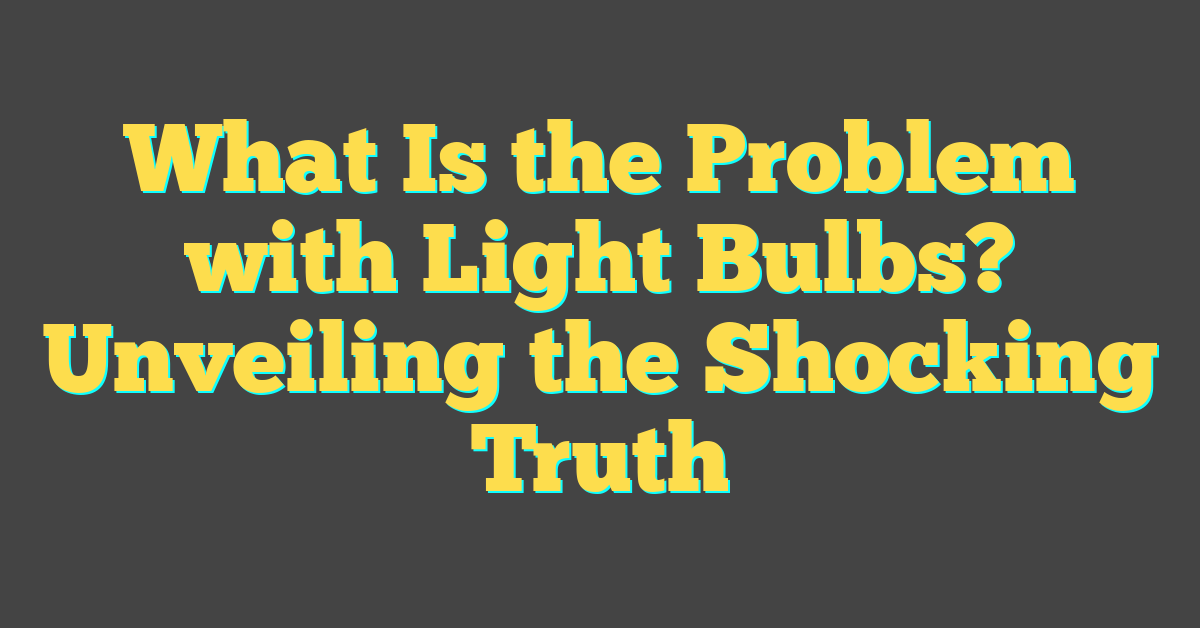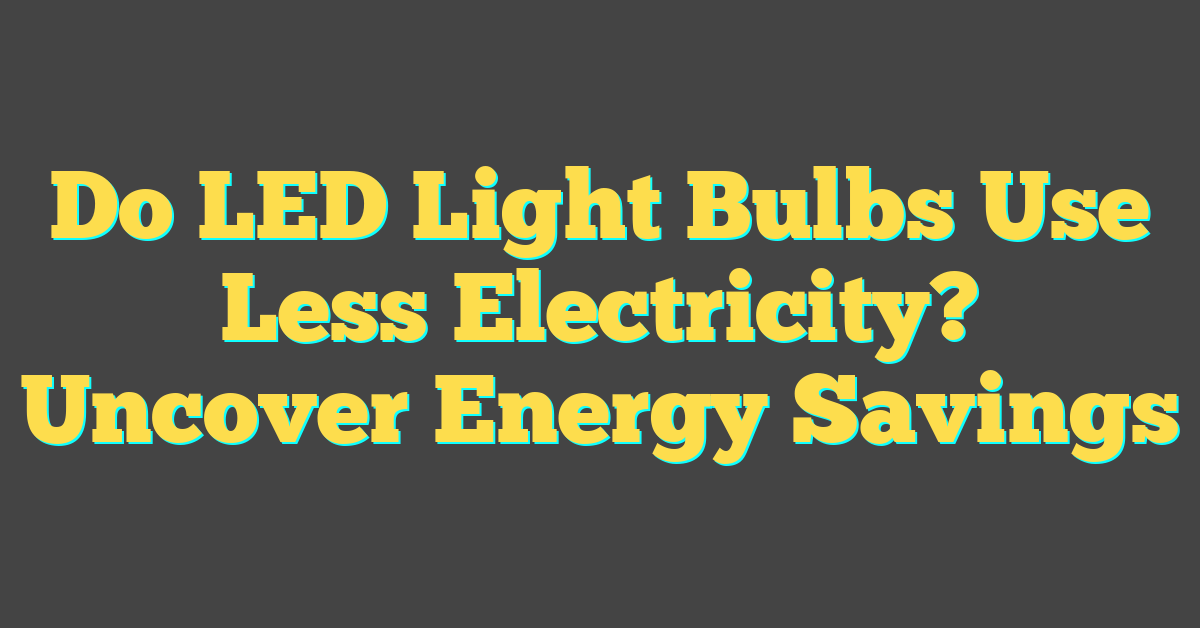Ever wondered why you’re changing light bulbs more often than you’d like? It’s not just you. There’s a real issue with the longevity and efficiency of the light bulbs we use every day. From the moment you flick that switch, the clock starts ticking on how long your bulb will last.

But longevity isn’t the only problem. You’ve probably heard about energy consumption and how it affects your bills and the environment. Well, traditional light bulbs are energy hogs, and there’s a growing concern about their environmental impact. Let’s shed some light on the problems lurking behind that bright glow.
The Short Lifespan of Light Bulbs
You’re swapping out light bulbs more often than you’d like, and it’s not just your imagination. Traditional incandescent light bulbs, which once illuminated homes everywhere, are notorious for their brief life expectancy. The average lifespan of these bulbs is about 1,000 to 2,000 hours. This means if you’re using your light for around three hours per day, you’ll be replacing it after just about a year.
Let’s shed some light on why these bulbs fizzle out so quickly. Incandescent bulbs work by heating a thin wire filament to a temperature that produces light. Over time, this filament thins out and eventually breaks, plunging your room back into darkness. The constant cycle of heating and cooling as you flick the switch on and off exacerbates this wear and tear, shortening the bulb’s life even further.
For those who love a well-lit home and are also savvy about home efficiency, this represents more than a minor annoyance; it’s a frequent maintenance hassle and an ongoing expense. To illuminate just how frequently you might be changing light bulbs, here’s a glimpse at the numbers:
| Type of Light Bulb | Average Lifespan (hours) |
|---|---|
| Incandescent | 1,000-2,000 |
| CFL | 8,000-15,000 |
| LED | 25,000-50,000 |
When you compare these numbers, it’s clear that diving into the world of longer-lasting options like CFLs (compact fluorescent lamps) and LEDs (light-emitting diodes) might save you time and effort in the long run. CFLs and LEDs have longer lifespans primarily because they operate using different, more durable mechanisms to create light.
Halogen bulbs, a type of incandescent light, do offer a bit more staying power, generally lasting around 2,000 to 4,000 hours. But even halogens can’t hold a candle to the longevity offered by their CFL and LED counterparts.
The Energy Consumption Problem

When you’re tackling home DIY projects, you’re often looking for ways to cut costs and increase efficiency, right? One aspect that might not immediately draw your attention is the silent energy guzzler in your home: incandescent light bulbs. They’re not only short-lived but also incredibly inefficient in terms of energy consumption. Let’s break it down.
Incredibly, about 90% of the energy used by traditional incandescent bulbs is emitted as heat, not as visible light. This is essentially energy that you’re paying for but not using to light your space. It’s like running your air conditioner with the windows open – wasteful and expensive.
The energy inefficiency of incandescent light bulbs becomes even more apparent when you compare them with their modern counterparts. CFLs and LEDs use a fraction of the energy to produce the same amount of light. To give you a clearer picture:
| Type of Bulb | Energy Used (Watts) | Light Output (Lumens) |
|---|---|---|
| Incandescent | 60 | 800 |
| CFL | 14 | 800 |
| LED | 10 | 800 |
This table shows you’re not just saving on replacement costs but also on your monthly energy bills. By choosing LEDs or CFLs, you are significantly reducing the energy demand from your home’s lighting.
Remember those cool evenings when you had to turn on the light and it suddenly felt like the room temperature spiked? That’s the heat output of incandescent bulbs at play. It’s little wonder why in a push for greener, more energy-efficient solutions, lighting technology has evolved so rapidly. In contrast, with energy-efficient bulbs, the excess heat produced is minimal, making your lighting choice both an economical and comfortable one.
For DIY enthusiasts, understanding the types of lighting you use around your home not only helps in making efficient decisions but also adds to your repertoire of smart home improvement tricks. As you weave your way through the aisles of hardware stores, keep an eye out for lumens as opposed to watts; this will guide you in selecting the most energy-efficient options for your lighting needs.
The Environmental Impact of Traditional Light Bulbs

« How to Stop Light Bulbs from Sticking: 5 Fail-Safe Methods Revealed
Why Are Light Bulbs Orange? Unlock the Cozy Secrets to Better Sleep »
When you’re caught up in the thrill of a DIY project, it’s easy to overlook the broader implications of your lighting choices. But it’s crucial to be aware that traditional incandescent light bulbs pose significant environmental issues. You probably know that they’re not as energy-efficient as their contemporary counterparts, but the concern goes deeper.
Traditional incandescent bulbs contribute to a higher demand for electricity, which frequently leads to increased greenhouse gas emissions from power plants. If you’re passionate about reducing your carbon footprint, it’s important to look at the type of bulbs you’re using.
Moreover, the production and disposal of these bulbs play a part in environmental harm. Incandescent bulbs contain materials that are difficult to recycle and often end up in landfills. As they break down over time, these materials may release toxins into the environment, causing long-term harm.
Upgrading to CFLs or LEDs not only reduces this waste but also lessens the associated manufacturing impact. Remember, it’s not just about the immediate energy saving—it’s also about reducing the lifecycle footprint of the products you bring into your home.
In addition to the eco-friendly aspect, swapping out your old bulbs contributes to a reduction in your personal energy bills. It’s a double win for you and the planet.
Finally, while considering your lighting options, think about how the design and placement of your fixtures can optimize natural light. Maximizing the use of daylight can significantly cut down on the need for artificial lighting, which in turn reduces energy consumption and environmental impact.
As you continue to tackle your home improvement projects, keep in mind that small changes in your lighting selection can have a big ripple effect on the environment. Your choices don’t just brighten up your home—they can also help illuminate a path to a more sustainable future.
The Shift to Energy-Efficient Alternatives

As you delve deeper into the world of lighting and seek out the best options for your DIY projects, you’ll find that the shift to energy-efficient alternatives is not just a trend, it’s a practical response to the inefficiencies of traditional lighting. Compact Fluorescent Lamps (CFLs) and Light Emitting Diodes (LEDs) represent the forefront of this evolution.
One of the most compelling reasons to consider CFLs is their extended lifespan. CFLs last about 8-10 times longer than incandescent bulbs, which means fewer trips to the store and less frequent replacements. This is not just convenient—it also reduces the amount of waste ending up in landfills.
LEDs take the benefits even further. An average LED has an impressive life expectancy of about 25,000 hours, and some high-quality models promise up to 50,000 hours. That’s years upon years of reliable lighting before you’d need to consider a replacement. Moreover, LEDs are known for their exceptional energy efficiency, using up to 75% less energy than incandescent bulbs.
| Bulb Type | Average Lifespan | Energy Savings |
|---|---|---|
| Incandescent | 1,000 hrs | – |
| CFL | 8,000-10,000 hrs | Up to 70% |
| LED | 25,000-50,000 hrs | Up to 75% |
The impact of energy-efficient lighting on your energy bill can be substantial. By replacing your home’s incandescent bulbs with LEDs, you could see a noticeable decrease in your monthly expenses, and that’s money you can put towards your next big project. Many utility companies often offer rebates or incentives for making the switch, providing extra savings.
Remember to look beyond the initial cost of these bulbs. While it’s true that CFLs and LEDs come with a higher price tag upfront, the long-term cost savings and fewer bulb replacements make them a smarter investment. Plus, they are available in various styles and colors, fitting seamlessly into any DIY undertaking.
Conclusion
You’ve seen the bright side of energy-efficient lighting and how it’s not just about saving the planet but also about saving your wallet. Remember, every time you switch on a CFL or LED, you’re not just lighting up your space—you’re making a choice that echoes into your future. Embracing these alternatives means fewer trips to the store for replacements and more money in your pocket over time. So next time you’re browsing the lighting aisle, think long-term and let those cost savings and stylish options light the way to a brighter, greener home.
Frequently Asked Questions
What are the energy-efficient alternatives to incandescent bulbs discussed in the article?
Energy-efficient alternatives to traditional incandescent bulbs discussed in the article are Compact Fluorescent Lamps (CFLs) and Light Emitting Diodes (LEDs).
How do the lifespans of CFLs and LEDs compare to incandescent bulbs?
CFLs and LEDs have a significantly extended lifespan compared to incandescent bulbs, which means they require fewer replacements and generate less waste.
What are the advantages of LEDs specifically?
LEDs are highlighted for their impressive life expectancy and exceptional energy efficiency, making them a superior choice for energy-saving lighting.
Can energy-efficient bulbs lead to cost savings?
Yes, using energy-efficient bulbs such as CFLs or LEDs can result in potential cost savings due to their reduced energy consumption and longer lifetimes.
Do utility companies offer rebates for using energy-efficient lighting?
Utility companies often provide rebates or incentives to customers who switch to energy-efficient lighting options like CFLs and LEDs.
What should consumers consider when selecting CFLs or LEDs for their DIY projects?
Consumers should consider long-term cost savings, as well as the variety of styles and colors available, when choosing energy-efficient CFLs or LEDs for DIY projects.




